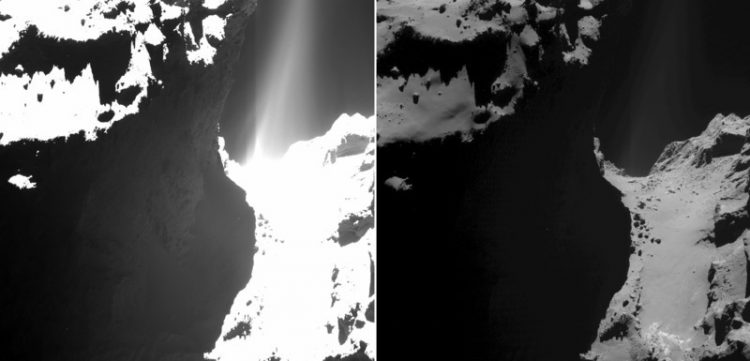A comet spews dust

A comet wakes up: Two views of the same region on the neck of comet 67P/Churyumov-Gerasimenko. The right image was taken with an exposure time of less than a second and shows details on the comet’s surface. The left image was overexposed (exposure time of 18.45 seconds) so that surface structures are obscured. At the same time, however, jets arising from the comet’s surface become visible. The images were obtained by the wide-angle camera of OSIRIS, Rosetta’s scientific imaging system, on 20 October, 2014 from a distance of 7.2 kilometers from the surface. © ESA/Rosetta/MPS for OSIRIS Team MPS/UPD/LAM/IAA/SSO/INTA/UPM/DASP/IDA
Rosetta’s comet 67P/Churyumov-Gerasimenko is beginning to show a clearly visible increase in activity. While in the past months most of the dust emitted from the body’s surface seemed to originate from the neck region which connects the two lobes, new images obtained by Rosetta’s scientific imaging system OSIRIS now show jets of dust along almost the whole body of the comet.
“At this point, we believe that a large fraction of the illuminated comet’s surface is displaying some level of activity”, says OSIRIS scientist Jean-Baptiste Vincent from the Max Planck Institute for Solar System Research (MPS) in Germany. During the past few weeks, the OSIRIS team has witnessed a gradual but qualitative change. “In the first images from this summer that showed distinct jets of dust leaving the comet, these jets were limited to the neck region”, says OSIRIS Principal Investigator Holger Sierks from the MPS. Now, jets appear also on the “body” and “head” of the comet.
Currently, still more than 450 million kilometers are separating 67P from the Sun. Based on a rich history of ground-based observations scientists expect a comet’s activity to pick-up noticeably once it comes within 300 million kilometers of the Sun. “Being able to monitor these emissions from up close for the first time gives us much more detailed insights”, says Sierks. From the OSIRIS images, the team now wants to derive a better understanding of the evolution of cometary activity and the physical processes driving it.
Since under normal circumstances, the comet’s nucleus would outshine the jets, the necessary images must be drastically overexposed. “In addition, one image alone cannot tell us the whole story”, says Sierks. “From one image we cannot discern exactly where on the surface a jet arises.” Instead, the researchers compare images of the same region taken from different angles in order to reconstruct the three-dimensional structure of the jets.
While 67P’s overall activity is clearly increasing, the mission’s designated landing site on the “head” of the comet still seems to be rather quiet. However, there is some indication that new active areas are waking up about one kilometer from landing area J. These will allow the lander’s instruments to study the comet’s activity from an even closer distance.
Rosetta is an ESA mission with contributions from its member states and NASA. Rosetta's Philae lander is provided by a consortium led by DLR, MPS, CNES and ASI. Rosetta will be the first mission in history to rendezvous with a comet, escort it as it orbits the Sun, and deploy a lander to its surface.
The scientific imaging system OSIRIS was built by a consortium led by the Max Planck Institute for Solar System Research (Germany) in collaboration with CISAS, University of Padova (Italy), the Laboratoire d'Astrophysique de Marseille (France), the Instituto de Astrofísica de Andalucia, CSIC (Spain), the Scientific Support Office of the European Space Agency (The Netherlands), the Instituto Nacional de Técnica Aeroespacial (Spain), the Universidad Politéchnica de Madrid (Spain), the Department of Physics and Astronomy of Uppsala University (Sweden), and the Institute of Computer and Network Engineering of the TU Braunschweig (Germany). OSIRIS was financially supported by the national funding agencies of Germany (DLR), France (CNES), Italy (ASI), Spain (MEC), and Sweden (SNSB) and the ESA Technical Directorate.
Contact
Dr. Birgit Krummheuer
Max Planck Institute for Solar System Research, Göttingen
Dr. Holger Sierks
Max Planck Institute for Solar System Research, Göttingen
Media Contact
All latest news from the category: Physics and Astronomy
This area deals with the fundamental laws and building blocks of nature and how they interact, the properties and the behavior of matter, and research into space and time and their structures.
innovations-report provides in-depth reports and articles on subjects such as astrophysics, laser technologies, nuclear, quantum, particle and solid-state physics, nanotechnologies, planetary research and findings (Mars, Venus) and developments related to the Hubble Telescope.
Newest articles

Silicon Carbide Innovation Alliance to drive industrial-scale semiconductor work
Known for its ability to withstand extreme environments and high voltages, silicon carbide (SiC) is a semiconducting material made up of silicon and carbon atoms arranged into crystals that is…

New SPECT/CT technique shows impressive biomarker identification
…offers increased access for prostate cancer patients. A novel SPECT/CT acquisition method can accurately detect radiopharmaceutical biodistribution in a convenient manner for prostate cancer patients, opening the door for more…

How 3D printers can give robots a soft touch
Soft skin coverings and touch sensors have emerged as a promising feature for robots that are both safer and more intuitive for human interaction, but they are expensive and difficult…





















